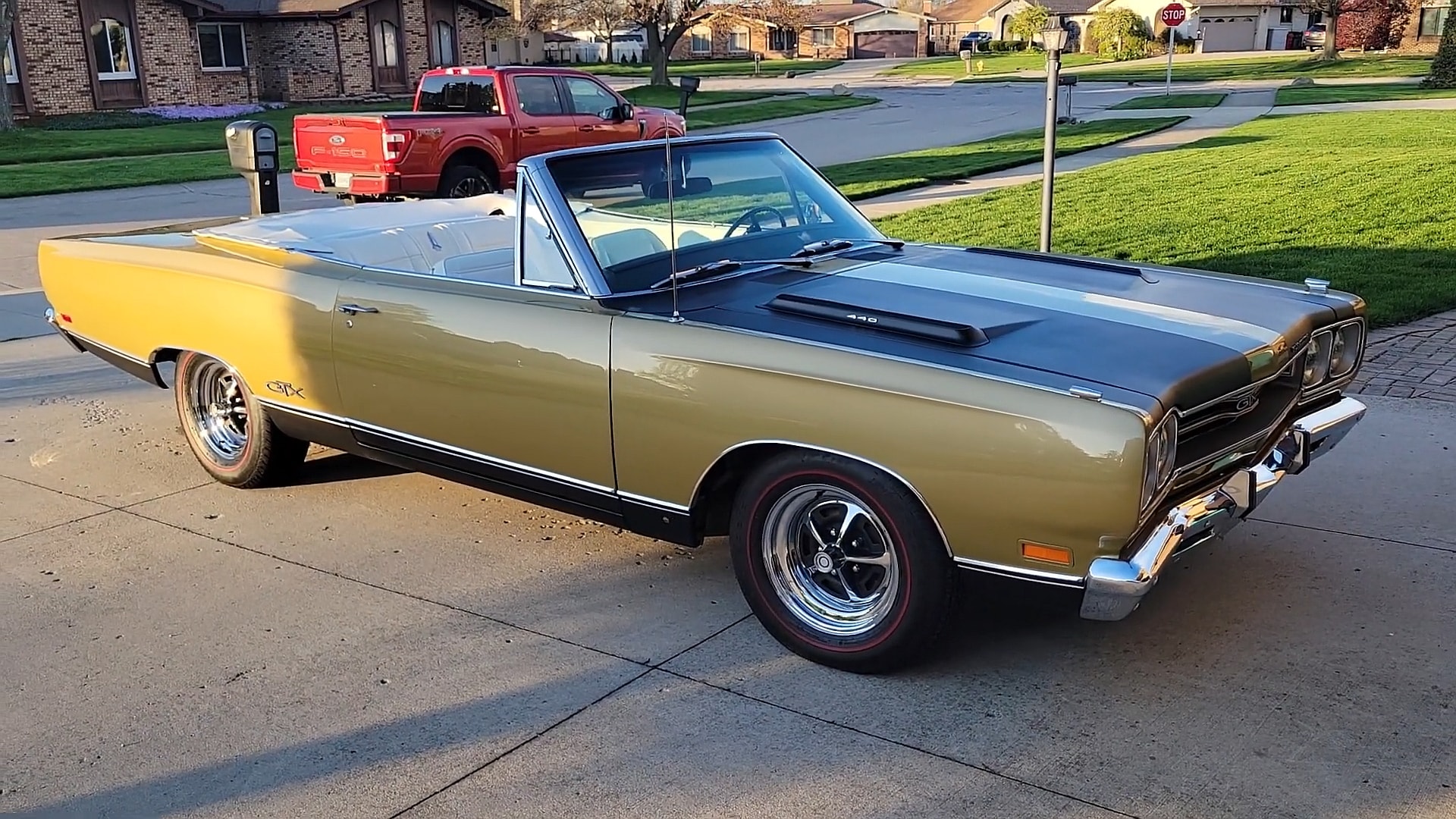Today, automatic transmissions dominate the market, with only 1.7% of new cars in 2023 coming with a manual, according to J.D. Power. While manual gearboxes are often more reliable, most drivers now prefer the ease of automatics or paddle shifters.
However, during the golden age of muscle cars in the late ’60s and early ’70s, manual transmissions were far more common, especially in cars with massive torque. Many of these high-powered muscle cars came standard with a manual gearbox, though automatics were sometimes optional.
Daxstreet dug into the archives and gathered information from trusted sources to find some of the highest torque muscle cars from the ’70s that came with a manual transmission. These classics were built with torque figures that are still impressive by today’s standards.
5) 1971 Plymouth Hemi Barracuda: A Rare Muscle Car Icon
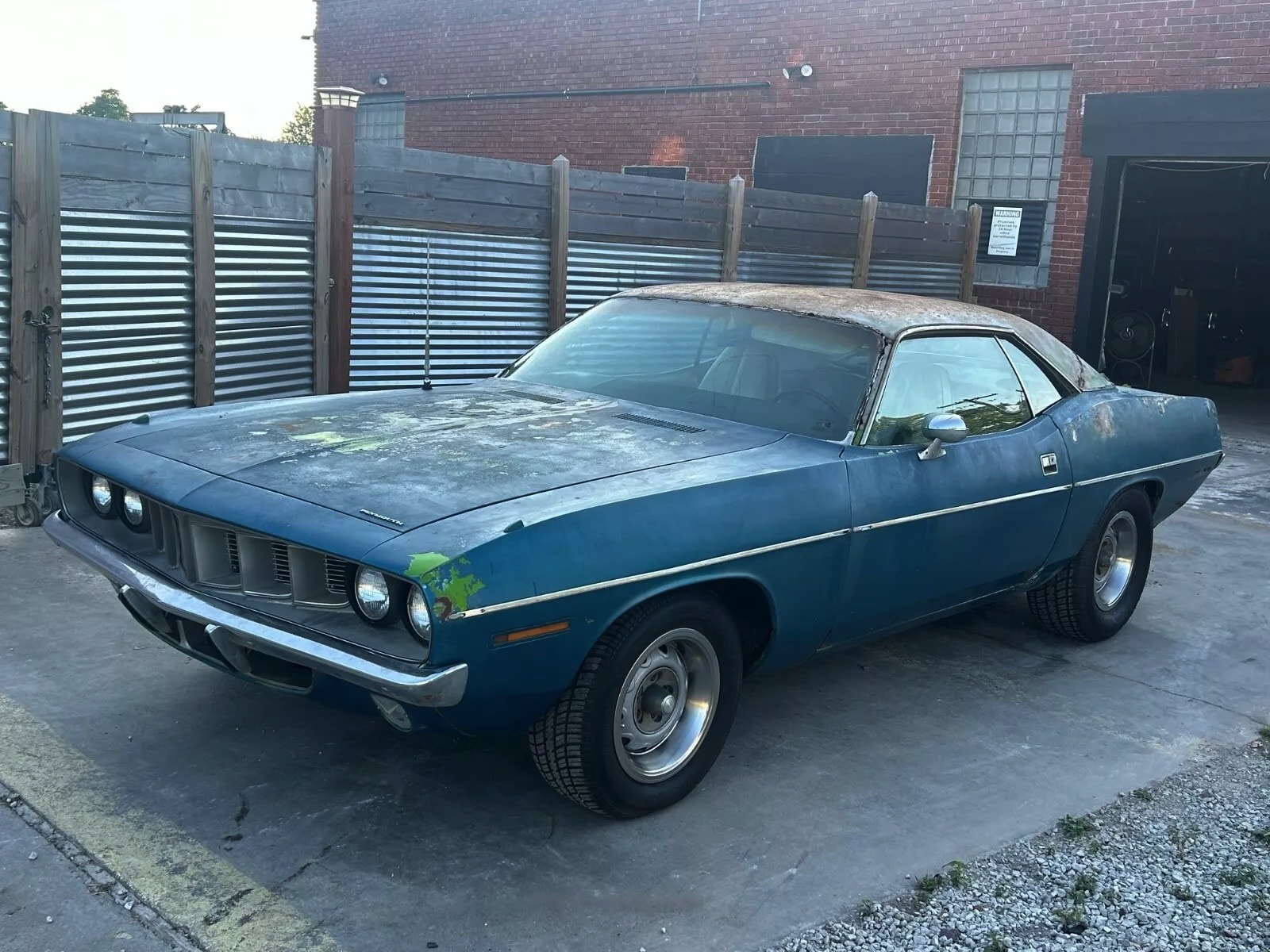
The 1971 Plymouth Hemi Barracuda, often referred to simply as the Hemi ‘Cuda, is one of the most legendary muscle cars ever produced. Known for its striking design and powerful engine, this car holds a special place in the hearts of automotive enthusiasts and collectors alike. With its impressive performance and limited production numbers, the Hemi ‘Cuda is not just a car; it’s a piece of history.
At the core of the 1971 Hemi Barracuda is the formidable 7.2-liter V8 engine. This powerful HEMI engine produces 390 horsepower and an impressive 490 lb-ft of torque, making it a force to be reckoned with on the road. The Hemi engine was known for its exceptional power and performance, allowing the ‘Cuda to deliver thrilling acceleration and an exhilarating driving experience.
One of the standout features of the 1971 Hemi Barracuda is its rarity. Only 771 units were produced with the HEMI engine, which adds to its allure among collectors. This limited production makes it one of the most sought-after muscle cars today, with prices reaching up to half a million dollars for well-preserved models. The rarity of the Hemi ‘Cuda means that owning one is a significant achievement for any car enthusiast.
The Hemi Barracuda offered flexibility when it came to transmission options. Buyers could choose between a 3-speed automatic transmission or a 3- or 4-speed manual transmission. This variety allowed drivers to tailor their driving experience to their preferences, whether they wanted a more traditional manual shift or the convenience of an automatic.
To handle the immense power of the HEMI engine, the 1971 Barracuda featured upgraded suspension components. These enhancements provided a more controlled and stable driving experience, allowing the car to find curves and turns with confidence. The combination of power and handling made the Hemi ‘Cuda a standout performer both on the street and at the drag strip.
The 1971 Plymouth Hemi Barracuda is a rare gem in muscle cars. With its powerful engine, limited production, and enhanced features, it represents the pinnacle of American automotive performance from its era. For collectors and enthusiasts, the Hemi ‘Cuda is more than just a car;
it’s a symbol of speed, power, and automotive excellence that continues to grab generations. Whether seen in car shows or on the open road, the Hemi Barracuda is a true icon of American muscle car history.
The Plymouth Hemi Barracuda, often simply referred to as the “Hemi ‘Cuda,” is one of the most celebrated muscle cars in automotive history. Introduced in 1970 as part of Plymouth’s Barracuda line, the Hemi ‘Cuda quickly became synonymous with raw power, performance, and aggressive styling. Known for its limited production numbers and extraordinary capabilities, it has garnered a legendary status among collectors and enthusiasts alike.
At the core of the Hemi Barracuda is the iconic 426 cubic inch (7.0-liter) Hemi V8 engine. This powerhouse was designed specifically for high-performance applications and was derived from Chrysler’s racing engines.
The Hemi engine produced an impressive 425 horsepower and 490 lb-ft of torque, which made the Hemi ‘Cuda one of the most powerful muscle cars of its era. The Hemi’s unique design featured hemispherical combustion chambers, which allowed for better airflow and improved combustion efficiency, contributing to the engine’s robust performance.
The acceleration capabilities of the Hemi Barracuda were nothing short of extraordinary. With its powerful engine, the Hemi ‘Cuda could accelerate from 0 to 60 mph in just over 5 seconds and cover the quarter-mile in around 13.5 seconds. This performance made it a fierce competitor on both the streets and the drag strips, appealing to those who craved speed and excitement.
In terms of design, the Plymouth Hemi Barracuda featured an aggressive and muscular stance that set it apart from other muscle cars of the time. The long hood and short rear deck gave it a distinctive profile, while the wide front grille and dual headlights added to its imposing presence.
The Hemi ‘Cuda was available in a variety of bold colors, including “Plum Crazy,” “Hemi Orange,” and “Tor-Red,” which further emphasized its sporty character. The distinctive “Hemi” decals and functional hood scoops enhanced the car’s visual appeal and served a practical purpose by improving engine airflow.
Inside, the Hemi Barracuda offered a driver-focused cockpit designed for both comfort and performance. The interior featured high-back bucket seats, a center console, and an instrument panel that included essential gauges for monitoring engine performance. Optional features such as woodgrain accents and upgraded upholstery added a touch of luxury to the performance-oriented design. The spacious cabin comfortably accommodated up to five passengers, making it suitable for both spirited driving and everyday use.
The handling dynamics of the Hemi Barracuda were equally impressive, thanks to its heavy-duty suspension and performance-tuned chassis. Equipped with reinforced springs, heavy-duty shock absorbers, and a larger rear axle, the Hemi ‘Cuda was designed to handle the immense power generated by its engine. This setup provided excellent stability and control during aggressive driving, allowing the car to find turns and curves with confidence.
One of the most appealing aspects of the Hemi Barracuda is its rarity. Only **652 units** of the Hemi-powered ‘Cuda were produced in 1970, making it one of the most limited-production muscle cars in history. The combination of low production numbers, high performance, and iconic styling has made the Hemi ‘Cuda a highly sought-after collector’s item, often commanding impressive prices at auctions and classic car shows.
The legacy of the Plymouth Hemi Barracuda extends beyond its production years. Although the Barracuda was discontinued in the mid-1970s due to changing market conditions and regulations, its influence on the automotive remains significant. The Hemi ‘Cuda has been featured in numerous films, television shows, and pop culture references, solidifying its status as an American icon.
Today, the Hemi Barracuda is not only a testament to the golden age of muscle cars but also a symbol of power, performance, and American automotive engineering. Its storied past and connection to racing have contributed to its legendary status, making it a favorite among automotive enthusiasts and collectors. Restorations and custom builds of the Hemi ‘Cuda continue to thrive, showcasing the enduring appeal of this extraordinary vehicle.
The Plymouth Hemi Barracuda stands out as a quintessential representation of American muscle car culture. With its formidable 426 Hemi V8 engine, bold design, and limited production numbers, it remains a powerful symbol of performance and engineering excellence.
The Hemi ‘Cuda’s impact on the automotive world is undeniable, and it continues to grab car lovers and collectors alike, ensuring its place in the annals of automotive history. Whether on display at a car show or roaring down the highway, the Hemi Barracuda embodies the thrill of driving and the spirit of American muscle.
4) The 1970 Dodge Challenger R/T Hemi: A Muscle Car Icon
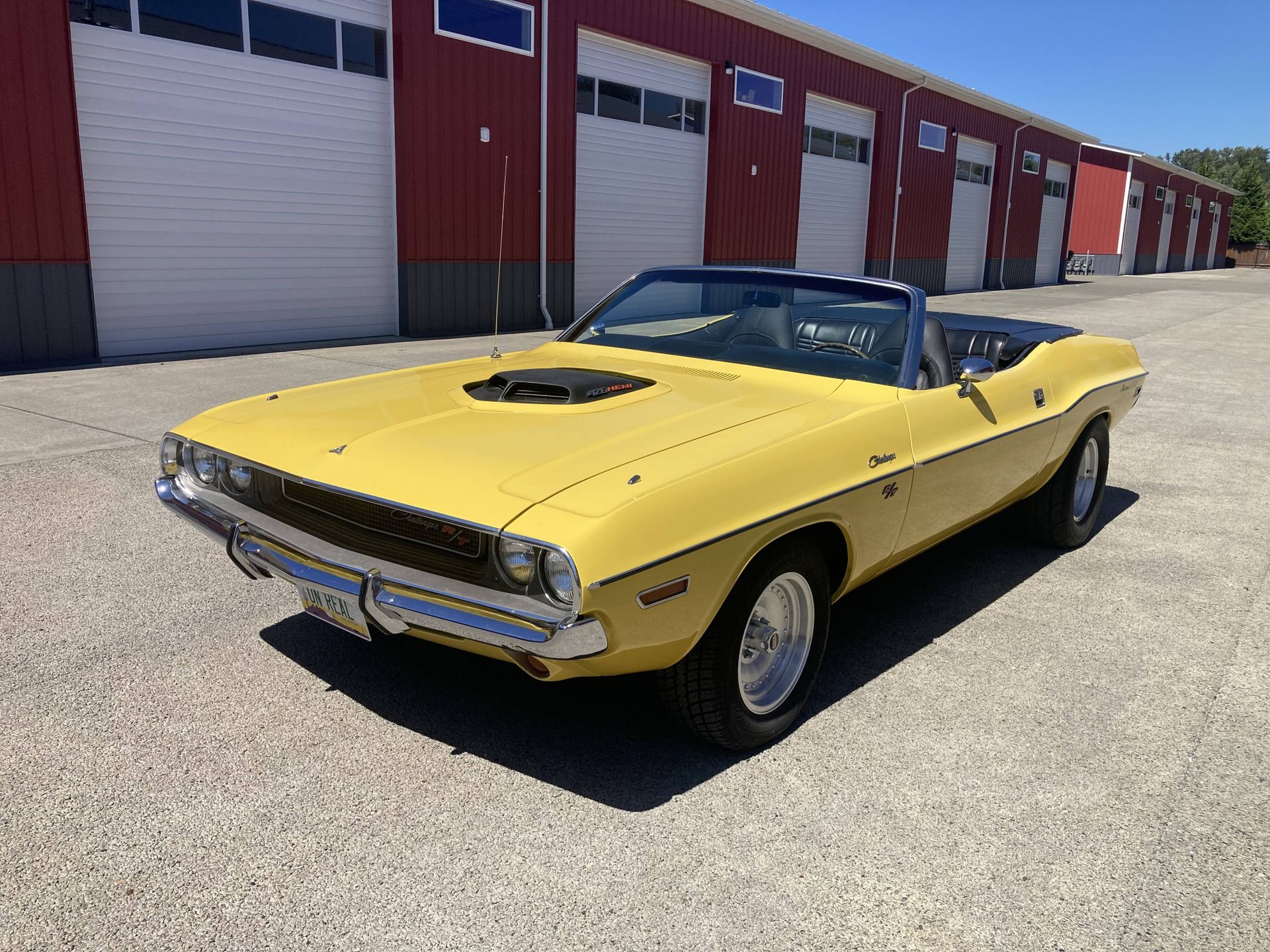
The 1970 Dodge Challenger R/T Hemi is a muscle car that truly embodies the spirit of American performance. Designed as Dodge’s answer to the Ford Mustang, the Challenger quickly made a name for itself in the competitive muscle car market. With its aggressive styling, powerful engine, and exciting features, the Challenger R/T Hemi became a favorite among car enthusiasts.
At the heart of the Challenger R/T is the legendary 7.0-liter Hemi V8 engine. This powerhouse delivers an impressive 425 horsepower and a staggering 490 lb-ft of torque, making it one of the most powerful muscle cars of its time. The Hemi engine is known for its high performance, providing thrilling acceleration and an exhilarating driving experience that keeps drivers coming back for more.
The Challenger R/T doesn’t just look good; it performs exceptionally well too. With the ability to complete the quarter-mile in just 13.1 seconds, this muscle car showcases its strength and speed on the drag strip. Whether you’re cruising down the highway or racing against the clock, the Challenger R/T Hemi is built to impress.
To handle the immense power generated by the Hemi engine, the Challenger R/T is equipped with an A833 heavy-duty four-speed manual transmission. This transmission not only allows for smooth gear shifts but also enhances the driving experience. The manual gearbox gives drivers complete control over the car, making it feel more engaging and thrilling on the road.
The Challenger R/T is loaded with features that enhance its appeal. One of the standout options is the Rallye instrument cluster, which boasts a speedometer that reaches up to 150 mph and an 8,000 RPM tachometer.
These gauges add a sporty touch to the interior, allowing drivers to keep track of their performance with style. Additionally, the famous shaker hood scoop not only adds to the car’s aggressive look but also helps improve engine performance by drawing in more air.
The 1970 Dodge Challenger R/T Hemi is a true icon of American muscle cars. With its powerful engine, impressive performance, and distinctive features, it captures the essence of the muscle car era. Whether you’re a collector or simply an admirer of classic cars, the Challenger R/T Hemi represents the pinnacle of automotive engineering and design. Its combination of power and style ensures that it remains a beloved symbol of American automotive history.
The Dodge Challenger R/T Hemi is a quintessential American muscle car that epitomizes raw power, aggressive styling, and a rich automotive heritage. Originally introduced in 1970, the Challenger was Dodge’s answer to the muscle car craze sweeping the United States.
The R/T (Road/Track) trim level was designed for performance enthusiasts who demanded more from their vehicles, and the inclusion of the legendary Hemi engine has become synonymous with power and performance in the automotive world.
The 1970 Dodge Challenger R/T Hemi featured a 426 cubic inch (7.0-liter) Hemi V8 engine, which was one of the most powerful engines available at the time. This beast of an engine produced an astonishing 425 horsepower and 490 lb-ft of torque, making it one of the most formidable powertrains in the muscle car market. The Hemi V8 was renowned for its ability to deliver impressive acceleration and speed, with the capability of propelling the Challenger from 0 to 60 mph in just over five seconds. This performance made it a favorite among drag racers and car enthusiasts alike.
In terms of design, the Dodge Challenger R/T Hemi was characterized by its aggressive stance, long hood, and wide body. The front end featured a bold grille and dual headlights, while the rear showcased a muscular design with prominent taillights.
The R/T trim came with unique badging and options for a functional hood scoop, which not only enhanced the car’s aesthetics but also contributed to its performance by allowing for improved airflow to the engine. Available in vibrant colors such as Plum Crazy and Hemi Orange, the Challenger R/T Hemi was visually striking and commanded attention on the road.
Inside, the Challenger R/T Hemi offered a driver-focused cockpit with comfortable seating for up to five passengers. The interior was designed with a blend of sportiness and comfort, featuring high-quality materials and available options like leather upholstery and wood accents.
The dashboard included clear gauges and controls, emphasizing the driver’s experience. Performance-oriented features, such as bucket seats and a sporty steering wheel, further enhanced the driving experience, making the R/T a car that was both fun to drive and comfortable for long journeys.
The performance of the Dodge Challenger R/T Hemi was not limited to its straight-line speed. The car was equipped with a heavy-duty suspension system designed to handle the immense power of the Hemi engine.
This included reinforced springs, shock absorbers, and a rear stabilizer bar that improved handling and stability during spirited driving. The combination of a powerful engine and a well-tuned suspension allowed the Challenger R/T Hemi to excel not only on the drag strip but also on winding roads and racetracks.
The Dodge Challenger R/T Hemi quickly gained a reputation in the automotive community as one of the most powerful and iconic muscle cars of its time. It was a symbol of American automotive culture, appealing to a generation that valued speed, power, and individuality. The Challenger was featured in various films and television shows, further cementing its status as an American icon and a favorite among car enthusiasts.
Although the original production of the Challenger ended in 1974, the nameplate was revived in 2008, and the modern iterations have sought to capture the spirit of the classic models. The current Dodge Challenger R/T continues to offer Hemi engine options, maintaining the connection to its powerful past. The modern version combines classic muscle car aesthetics with contemporary technology, making it appealing to both nostalgic enthusiasts and new generations of drivers.
The legacy of the Dodge Challenger R/T Hemi is evident in its enduring popularity among collectors and enthusiasts. The classic models remain highly sought after at auctions and car shows, often fetching impressive prices due to their rarity and iconic status. Restorations of these classic muscle cars have become a popular hobby among automotive enthusiasts, ensuring that the spirit of the Challenger R/T Hemi lives on.
The Dodge Challenger R/T Hemi is a quintessential representation of American muscle car culture. With its powerful Hemi V8 engine, aggressive design, and driver-focused interior, it remains a beloved classic that continues to inspire car enthusiasts and collectors alike.
The Challenger R/T Hemi stands as a testament to the golden age of muscle cars and the enduring appeal of performance vehicles that celebrate power, style, and individuality. Whether on the drag strip or cruising down the highway, the Dodge Challenger R/T Hemi represents the thrill of driving and the passion that defines the muscle car legacy.
3) The 1970 Buick GS 455 Stage 1 A Powerhouse of American Muscle
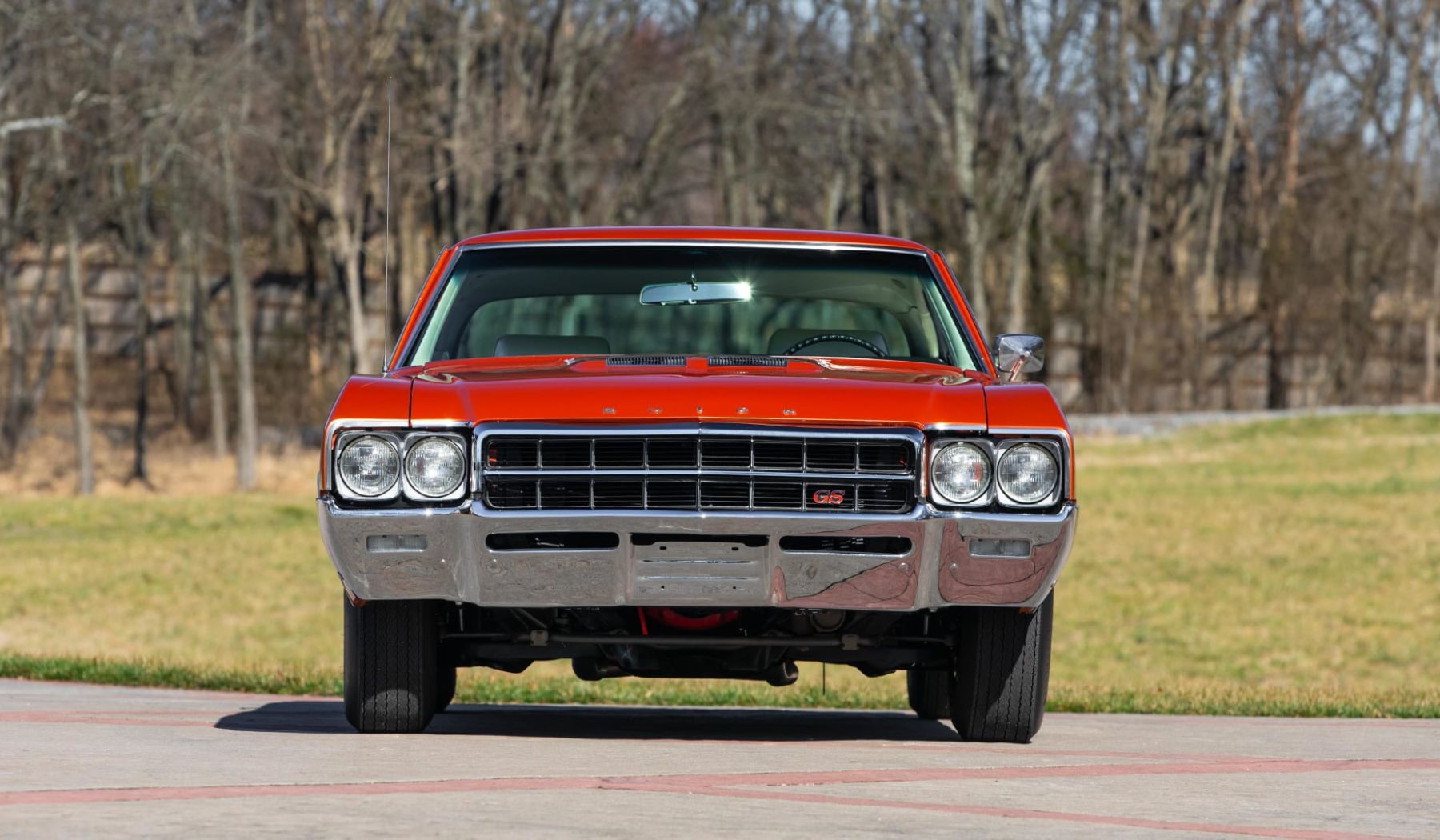
The 1970 Buick GS 455 Stage 1 is a standout muscle car that changed how people viewed Buick. Known for its performance and power, this car helped shake off Buick’s image of being a more conservative brand. With its aggressive design and impressive engine, the GS 455 Stage 1 is a classic that has earned its place in automotive history.
At the heart of the GS 455 Stage 1 is a massive 455 cubic-inch (cu-in) V8 engine. This powerful engine produces an impressive 360 horsepower, making it one of the strongest muscle cars of its time. But it’s not just about horsepower; the torque figures are staggering as well, with a whopping 510 lb-ft of torque. This high torque means that the GS 455 can accelerate quickly and deliver a thrilling driving experience.
The performance of the GS 455 Stage 1 is nothing short of exhilarating. It can sprint through the quarter mile in just 13.5 seconds, which is remarkable for a car from this era. The combination of its powerful engine and a well-tuned chassis allows the GS 455 Stage 1 to handle the road with confidence, making it a joy to drive whether you’re cruising on the highway or tearing up the track.
The design of the GS 455 Stage 1 is just as impressive as its performance. With bold lines, an aggressive stance, and classic muscle car proportions, this car looks as powerful as it performs. The front grille and distinctive styling details make it instantly recognizable, and the aesthetic reflects the muscle car era’s spirit.
The 1970 Buick GS 455 Stage 1 is not just about raw power; it represents a significant moment in automotive history. Buick took a big step forward by offering a high-performance model that could compete with the best in the muscle car segment. The GS 455 helped redefine the brand, attracting a new generation of performance enthusiasts.
Today, the 1970 Buick GS 455 Stage 1 is celebrated as one of the icons of American muscle. With its powerful engine, impressive torque, and striking design, it is a car that continues to turn heads and excite drivers. For car collectors and enthusiasts, the GS 455 Stage 1 remains a cherished piece of automotive history that exemplifies the golden age of muscle cars. Whether on the road or displayed in a collection, this powerhouse is a testament to the spirit of American performance.
The Buick GS 455 Stage 1 is a significant model in the history of American muscle cars, known for its powerful performance, distinctive styling, and lasting legacy. Launched in 1970, the GS (Gran Sport) series was Buick’s response to the growing demand for high-performance vehicles during the muscle car era. The GS 455 Stage 1 quickly established itself as a formidable contender in the competitive muscle car market, appealing to enthusiasts with its combination of power and luxury.
At the heart of the GS 455 Stage 1 was the impressive 455 cubic inch (7.5 liters) V8 engine, which was designed to deliver exhilarating performance. In its Stage 1 configuration, this engine produced an astounding 510 lb-ft of torque and 360 horsepower, making it one of the most powerful engines of its time. This level of power allowed the GS 455 Stage 1 to accelerate from 0 to 60 mph in just over six seconds, showcasing its capability both on the street and at the drag strip.
The GS 455 Stage 1 came with a host of performance features that set it apart from the standard GS models. These included larger intake and exhaust valves, a higher compression ratio, and a specially tuned carburetor. The vehicle was offered with either a three-speed Turbo Hydra-Matic automatic transmission or a four-speed manual transmission, giving drivers the option to tailor their driving experience to their preference. The suspension was also upgraded to handle the added power, with heavy-duty springs and shock absorbers designed to improve handling and stability.
In terms of design, the Buick GS 455 Stage 1 boasted an aggressive and muscular appearance that reflected its performance capabilities. The long hood, wide stance, and flowing lines gave the car an imposing presence on the road. Unique styling elements included the prominent front grille with the iconic Buick logo, functional air scoops on the hood, and distinctive GS badging. Buyers could choose from a range of vibrant colors, including Saturn Yellow and Apollo White, which contributed to the car’s sporty image.
The interior of the GS 455 Stage 1 was designed with comfort and luxury in mind, providing a driver-focused experience. The spacious cabin could accommodate up to five passengers and featured high-quality materials, including optional leather upholstery and wood grain accents. The dashboard was equipped with clear gauges and controls for easy access, while options like air conditioning and an upgraded sound system enhanced the driving experience.
One of the most impressive aspects of the GS 455 Stage 1 was its performance on the road. With its powerful engine and well-tuned suspension, the car could handle both straight-line acceleration and winding curves with ease. It was equipped with a heavy-duty rear axle and performance tires, contributing to its ability to put power to the ground effectively. The combination of power, handling, and braking made the GS 455 Stage 1 a favorite among enthusiasts and a respected competitor in the muscle car scene.
The Buick GS 455 Stage 1 has become a sought-after collector’s item, with its limited production numbers contributing to its desirability. Only a few thousand units were produced during its brief run, making it a rare find today. This rarity, combined with its performance pedigree and classic styling, has led to a resurgence of interest among classic car collectors and enthusiasts.
In the context of American automotive history, the Buick GS 455 Stage 1 represents the peak of the muscle car era, a time when performance and style were paramount. It was a vehicle that embodied the spirit of freedom and rebellion that defined the 1970s, appealing to a generation that craved power and excitement behind the wheel.
Despite the challenges faced by the muscle car market in the following years due to increasing emissions regulations and changing consumer preferences, the Buick GS 455 Stage 1 has endured as a symbol of American automotive excellence. Today, it is celebrated not only for its impressive specifications but also for its place in the cultural of the time.
The Buick GS 455 Stage 1 is a remarkable classic that stands as a testament to Buick’s engineering prowess and commitment to performance. With its powerful 455 V8 engine, striking design, and luxurious interior, the GS 455 Stage 1 continues to capture the imagination of car enthusiasts around the world. Its legacy as one of the most iconic muscle cars of the era ensures that it remains a cherished part of American automotive history.
2) The 1970 Buick GSX Stage 1: A Torque Titan of Muscle Cars
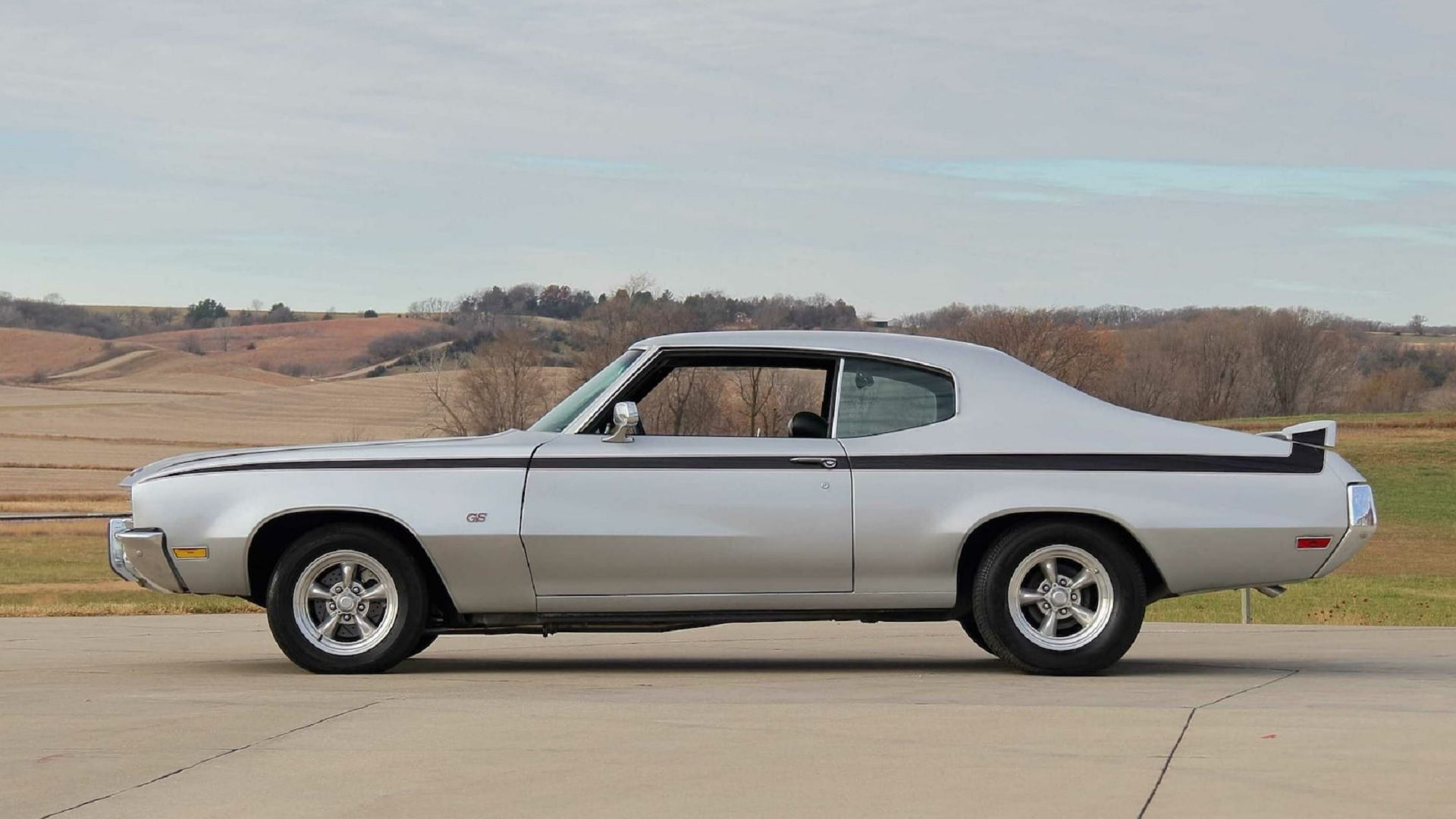
The 1970 Buick GSX Stage 1 is a classic muscle car that truly stands out from the crowd. With its eye-catching design and impressive performance, it represents the golden age of American muscle cars. The GSX is not just about looks; it packs a serious punch under the hood, making it a favorite among car enthusiasts.
At the heart of the Buick GSX Stage 1 lies a massive 7.5-liter V8 engine, known as the 455. This powerhouse produces an impressive 360 horsepower, but what really sets it apart is its torque. With a staggering 510 lb-ft of torque, the GSX Stage 1 delivers an incredible driving experience that is hard to match. This high level of torque means the car can accelerate quickly and smoothly, making it a joy to drive.
Buick made sure that the GSX Stage 1 was built for performance. The engine features an upgraded camshaft, higher compression, and a fully tuned four-barrel Quadrajet carburetor. These enhancements give the Stage 1 a slight bump in horsepower over the base model, but it’s the torque that truly makes it special. With a quarter-mile time of just 14.4 seconds, the GSX Stage 1 proves that it can hold its own against some of the best muscle cars of its era.
Not only is the GSX Stage 1 powerful, but it also boasts a stunning design that captures the essence of classic muscle cars. With its bold lines and aggressive stance, the GSX Stage 1 looks as tough as it performs. The distinctive styling elements, such as the wide body and striking color options, make it instantly recognizable on the road. This car isn’t just built to perform; it’s built to turn heads.
The Buick GSX Stage 1 holds a special place in the history of American muscle cars. It is a symbol of the power and performance that defined this era of automotive engineering. Only a limited number of these cars were produced, making them a rare find today. As a result, the GSX Stage 1 has become a highly sought-after collector’s item, admired for its performance, design, and history.
The 1970 Buick GSX Stage 1 is a true muscle car legend. With its powerful engine, impressive torque, and stunning looks, it stands as a testament to Buick’s commitment to performance and style. Whether you’re a car enthusiast or a collector, the GSX Stage 1 is an iconic piece of automotive history that continues to capture the hearts of those who appreciate classic American muscle.
The Buick GSX Stage 1 is a classic American muscle car that stands out for its blend of performance, style, and historical significance. Launched in the early 1970s, the GSX (Gran Sport Experimental) package was Buick’s answer to the muscle car craze, emphasizing power and luxury. The Stage 1 designation further elevated the performance of this already impressive vehicle, making it a formidable contender in the muscle car arena.
The GSX Stage 1 debuted in 1970 as an option for the Buick Skylark, and it quickly gained a reputation for being one of the fastest muscle cars of its time. The GSX Stage 1 was powered by a massive 455 cubic inch (7.5-liter) V8 engine, which produced a staggering 360 horsepower and 510 lb-ft of torque. This engine was mated to either a three-speed Turbo Hydra-Matic automatic transmission or a four-speed manual transmission, allowing drivers to choose their preferred driving experience.
One of the most notable features of the GSX Stage 1 is its unique design. The car was offered in striking colors, such as Saturn Yellow and Apollo White, complemented by distinctive GSX striping and badging. The exterior design was both aggressive and stylish, with a long hood and a wide stance that conveyed a sense of power and presence. The front end featured a bold grille and dual headlights, while the rear showcased a muscular design with integrated taillights.
The interior of the Buick GSX Stage 1 was designed with comfort and luxury in mind. It offered spacious seating for up to five passengers, with options for premium upholstery and wood grain accents. The dashboard was driver-focused, with clear gauges and controls positioned for easy access. The car also featured options like air conditioning, power windows, and an upgraded audio system, catering to those who desired both performance and comfort.
Performance-wise, the GSX Stage 1 was nothing short of impressive. With its powerful engine and well-tuned suspension, it could accelerate from 0 to 60 mph in just over six seconds, making it a true performer on the street. The car’s heavy-duty suspension system included front and rear stabilizer bars, which improved handling and stability, allowing for confident cornering. This made the GSX Stage 1 not only fast in straight lines but also capable of finding winding roads.
The GSX Stage 1’s reputation extended beyond its impressive specifications; it also left a significant mark on American automotive culture. The car was featured in numerous automotive publications and became a sought-after model for collectors and enthusiasts alike. Its limited production—only 678 units were built in 1970—adds to its allure and desirability in the classic car market today.
As emissions regulations tightened and fuel prices rose in the early 1970s, the muscle car era began to wane. However, the Buick GSX Stage 1 remains a symbol of the golden age of American muscle cars, embodying the spirit of performance and style that defined the era. Today, it is celebrated not only for its power and design but also for its place in automotive history.
The Buick GSX Stage 1 is an iconic muscle car that represents the pinnacle of performance, style, and luxury during a transformative period in the automotive industry. With its powerful 455 V8 engine, distinctive design, and driver-focused interior, the GSX Stage 1 remains a cherished classic among collectors and enthusiasts. Its legacy endures as a testament to Buick’s commitment to performance and innovation, making it a true classic that continues to capture the hearts of car lovers around the world.
1) The 1970 Chevrolet Chevelle SS 454: A Legendary Muscle Car
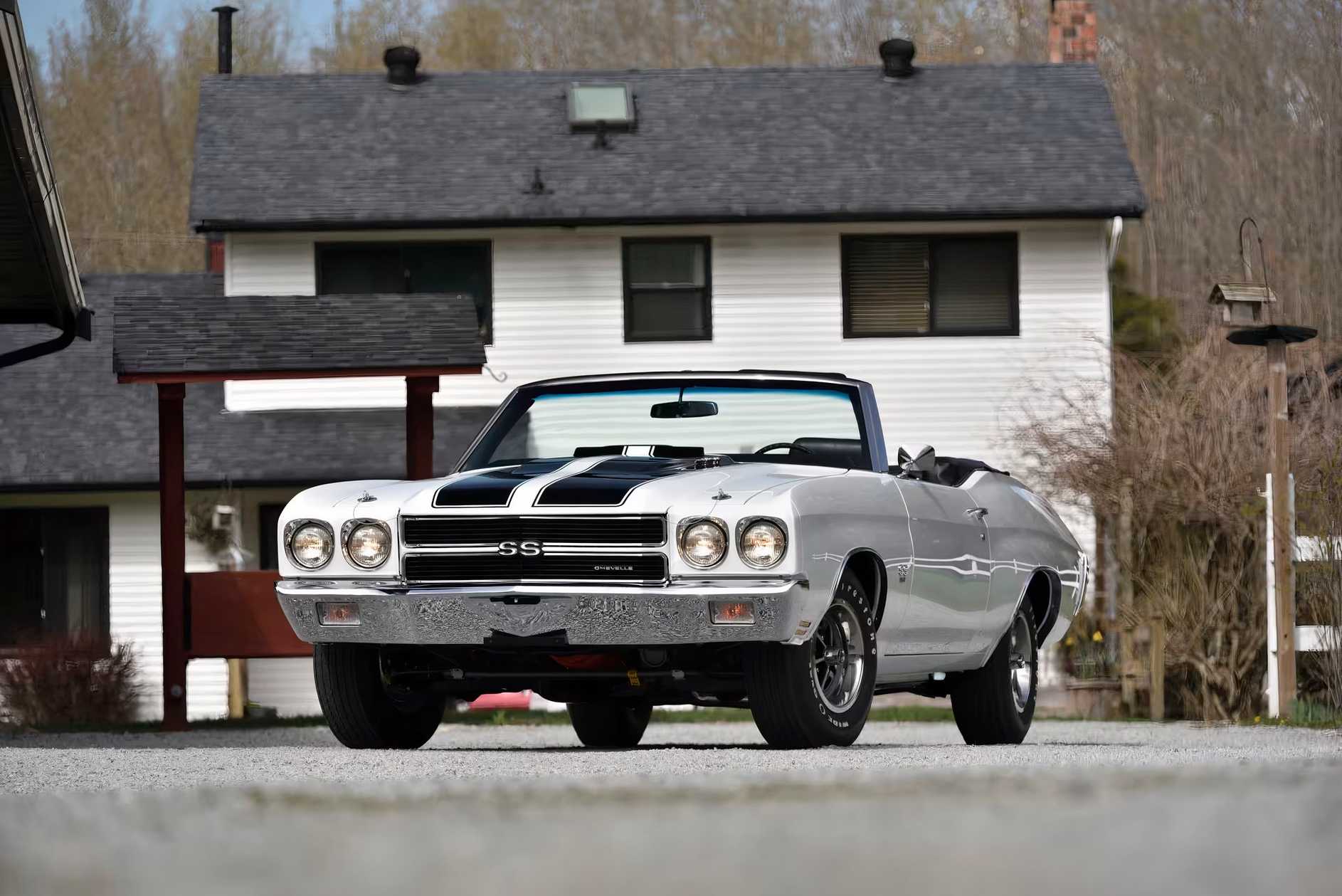
The 1970 Chevrolet Chevelle SS 454 is a legendary muscle car that represents the pinnacle of American performance in the early ’70s. Known for its impressive power and speed, the Chevelle SS 454 has become an iconic symbol of the muscle car era, combining striking looks with thrilling performance.
At the heart of the Chevelle SS 454 is a massive 454 cubic-inch (7.4-liter) V8 engine. This engine was groundbreaking, as it was the largest engine ever offered in a production car up to that time. It produces a robust 360 horsepower, which allowed the Chevelle to dominate the streets. Even more impressive is the torque figure, rated at around 500 lb-ft, providing the car with exceptional acceleration and pulling power.
The performance of the Chevelle SS 454 is nothing short of exhilarating. With a 0-60 mph time of just 5.7 seconds, it could easily leave many competitors in the dust. The combination of power and torque made for an incredibly responsive driving experience, whether you were launching off the line or cruising down the highway. This car could achieve a quarter-mile time of 13.8 seconds, making it one of the fastest muscle cars available at the time.
Buyers had the option to choose between two types of transmissions for the Chevelle SS 454. The M-22 four-speed manual transmission allowed drivers to take full control of the car’s power, enhancing the driving experience. Alternatively, the Turbo Hydra-Matic 400 automatic transmission provided a more relaxed driving experience while still delivering impressive performance.
The Chevelle SS 454 is not just about performance; it also boasts a bold and aggressive design. Its muscular stance, wide body, and iconic front grille give it an unmistakable presence on the road. The classic lines and curves of the Chevelle have made it a favorite among car enthusiasts and collectors alike.
The 1970 Chevrolet Chevelle SS 454 has left an indelible mark on American car culture. It represents the spirit of the muscle car era, where power and performance were king. Today, it remains highly sought after by collectors and enthusiasts who appreciate its blend of raw power, striking looks, and historical significance.
The 1970 Chevrolet Chevelle SS 454 is a true classic that exemplifies the essence of American muscle. With its enormous V8 engine, impressive torque, and stunning design, it stands out as one of the most iconic cars of its time. Whether on the track or as a collector’s item, the Chevelle SS 454 continues to inspire admiration and passion among car lovers around the world.
The Chevrolet Chevelle SS 454 is one of the most iconic American muscle cars of the 1970s, symbolizing raw power, aggressive styling, and the spirit of performance that defined a generation of car enthusiasts. Introduced in 1964 as part of Chevrolet’s mid-size lineup, the Chevelle quickly gained popularity for its combination of style, performance, and affordability. The SS (Super Sport) variant was introduced shortly after, representing the pinnacle of performance within the Chevelle range.
By the late 1960s and early 1970s, the muscle car era was in full swing, and Chevrolet responded by offering increasingly powerful engines, including the legendary 454 cubic inch (7.4 liters) V8 engine. The Chevelle SS 454 made its debut in 1970, equipped with this big-block V8, which was a significant selling point for enthusiasts craving power. The 1970 model year is often considered the high point of the Chevelle’s performance lineage, featuring aggressive styling and powerful engines that epitomized the muscle car era.
The Chevrolet Chevelle SS 454 boasted a muscular and aggressive design that set it apart from its contemporaries. The 1970 Chevelle was characterized by its long hood, short deck, and wide stance, giving it an imposing presence on the road. The SS package included distinctive features such as a bold front grille, SS badging, and dual exhaust outlets, emphasizing its performance-oriented identity. Inside, the Chevelle SS 454 offered a driver-focused cockpit with comfortable bucket seats and a sporty dashboard layout.
Options included a console-mounted four-speed manual transmission, providing a tactile and engaging driving experience. The interior design, while functional, exuded a sense of style that reflected the muscle car culture of the time. The 1970 Chevelle SS 454 was also available in a range of vibrant color options, including classic shades like Cranberry Red, Cortez Silver, and Fathom Blue, making it visually striking both in showrooms and on the streets.
At the heart of the Chevelle SS 454 was the formidable 454 cubic inch V8 engine, producing an impressive 360 horsepower in its standard form. This engine was capable of propelling the Chevelle from 0 to 60 mph in just a few seconds, providing thrilling acceleration that defined the muscle car experience. For those seeking even more power, an optional LS6 package increased output to a staggering 450 horsepower, solidifying the Chevelle’s reputation as one of the most powerful muscle cars of its time.
The performance of the Chevelle SS 454 was not limited to straight-line speed. The car’s suspension system was designed to handle the increased power, with heavy-duty springs, shock absorbers, and a sway bar to enhance stability and cornering performance. The optional F41 suspension package offered even more aggressive handling characteristics, allowing drivers to confidently tackle curves and twists. The SS 454’s power was delivered through a robust four-speed manual transmission, though a three-speed Turbo Hydra-Matic automatic transmission was also available.
The combination of a powerful engine and a well-tuned suspension made the Chevelle SS 454 a formidable performer, capable of dominating both the drag strip and the open road. The Chevrolet Chevelle SS 454 is not just a car; it’s a cultural icon representing the golden age of American muscle cars. During the 1970s, muscle cars were at the forefront of automotive culture, appealing to a generation that valued speed, power, and individuality.
The Chevelle SS 454, with its aggressive styling and powerful engine, became a symbol of freedom and rebellion, embodying the spirit of the era. In popular culture, the Chevelle SS 454 has made numerous appearances in films, television shows, and music, further cementing its status as an automotive legend. Its presence at car shows and auctions often commands attention, with enthusiasts willing to pay top dollar for well-preserved examples.
Despite the challenges faced by the muscle car industry in the late 1970s due to increasing emissions regulations and changing consumer preferences, the Chevrolet Chevelle SS 454 has left an indelible mark on automotive history. Today, it remains a highly sought-after classic car, with enthusiasts cherishing its combination of performance, style, and nostalgia. Restorations and custom builds have become popular among collectors, ensuring that the legacy of the Chevelle SS 454 lives on.
Enthusiast clubs and online communities dedicated to the Chevelle continue to thrive, providing a platform for owners and fans to share knowledge, experiences, and passion for this iconic muscle car. The Chevrolet Chevelle SS 454 is more than just a classic muscle car; it’s a symbol of an era defined by power, style, and the thrill of the open road. With its aggressive design, formidable performance, and cultural significance, it continues to capture the imagination of car enthusiasts around the world.
Whether admired at car shows, raced on the track, or lovingly restored in a garage, the Chevelle SS 454 stands as a testament to the enduring appeal of American muscle cars and the timeless quest for automotive excellence.

